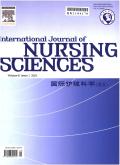中国孕妇妊娠前三个月的身体活动:一项横断面研究
IF 3.1
3区 医学
Q1 NURSING
引用次数: 0
摘要
目的:孕期体育锻炼对孕妇和胎儿都有好处;然而,在怀孕的前三个月,缺乏身体活动的比例很高。本研究旨在研究中国孕妇妊娠早期的身体活动模式,并阐明妊娠早期缺乏身体活动的相关特征。方法本横断面研究于2021年12月至2022年6月在中国广州市三家三级甲等医院进行。共有1283名孕妇参与了这项研究。妊娠身体活动问卷和社会人口和产科数据表收集了妊娠早期的信息。结果中国孕妇缺乏身体活动的发生率为51%。孕妇花在家务/照顾活动(中位数38.25小时/周)和久坐活动(中位数54.25小时/周)上的时间最多。孕妇更可能缺乏运动的特征包括年龄更小(OR: 1.413, 95% CI: 1.291, 1.767;P = 0.002),未婚(OR: 2.976, 95% CI: 1.573, 5.630;P = 0.001),月收入较低(OR: 1.945, 95% CI: 1.535, 2.464;P = 0.001),自费医疗(OR: 1.472, 95% CI: 1.140, 1.900;P = 0.003),未生育(OR: 3.169, 95% CI: 2.504, 4.009;P = 0.001),对孕期身体活动的认识不足(OR: 1.7997, 95% CI: 1.432, 2.255;P = 0.001),丈夫无体育活动习惯(OR:1.353, 95% CI: 1.081, 1.693;P = 0.008),无孕前体育锻炼习惯(OR: 1.832, 95% CI: 1.433, 2.340;P = 0.001)。结论妊娠早期妇女普遍缺乏身体活动。可将促进身体活动纳入常规产前保健。医疗保健专业人员应评估和监测孕妇的身体活动,并在妊娠头三个月期间就身体活动提供咨询,特别是对具有缺乏身体活动特征的孕妇。本文章由计算机程序翻译,如有差异,请以英文原文为准。
Physical activity among Chinese pregnant women in the first trimester: A cross-sectional study
Objectives
Physical activity during pregnancy benefits both women and their fetuses; however, the prevalence of physical inactivity is high among pregnant women in the first trimester. This study aimed to examine physical activity patterns among pregnant Chinese women in the first trimester and clarify the characteristics associated with physical inactivity in the first trimester.
Methods
This cross-sectional study was conducted at three Class-A tertiary hospitals in Guangzhou, city, China, from December 2021 to June 2022. A total of 1,283 pregnant women were enrolled. The Pregnancy Physical Activity Questionnaire and a sociodemographic and obstetric data sheet collected information in the first trimester.
Results
The prevalence of physical inactivity among Chinese pregnant women was 51 %. Pregnant women spent the most time in the domains of household/caregiving activities (median 38.25 h/week) and sedentary activities (median 54.25 h/week). Characteristics of pregnant women who were more likely to be physically inactive included younger age (OR: 1.413, 95 %CI: 1.291, 1.767; P = 0.002), unmarried (OR: 2.976, 95 %CI: 1.573, 5.630; P = 0.001), lower monthly income (OR: 1.945, 95 %CI: 1.535, 2.464; P = 0.001), self-paid medical care (OR: 1.472, 95 %CI: 1.140, 1.900; P = 0.003), nulliparous (OR: 3.169, 95 %CI: 2.504, 4.009; P = 0.001), inadequate knowledge about physical activity during pregnancy (OR: 1.797, 95 %CI: 1.432, 2.255; P = 0.001), husbands with no physical activity habits (OR:1.353, 95 %CI: 1.081, 1.693; P = 0.008), and no prepregnancy physical activity habits (OR: 1.832, 95 %CI: 1.433, 2.340; P = 0.001).
Conclusions
Physical inactivity was prevalent among pregnant women in the first trimester. Promoting physical activity could be incorporated into routine antenatal care. Healthcare professionals should assess and monitor the physical activity of pregnant women and provide consultations on physical activity during their first trimester, particularly for pregnant women with characteristics associated with physical inactivity.
求助全文
通过发布文献求助,成功后即可免费获取论文全文。
去求助
来源期刊

International Journal of Nursing Sciences
Nursing-Nursing (all)
CiteScore
6.10
自引率
2.60%
发文量
408
审稿时长
25 days
期刊介绍:
This journal aims to promote excellence in nursing and health care through the dissemination of the latest, evidence-based, peer-reviewed clinical information and original research, providing an international platform for exchanging knowledge, research findings and nursing practice experience. This journal covers a wide range of nursing topics such as advanced nursing practice, bio-psychosocial issues related to health, cultural perspectives, lifestyle change as a component of health promotion, chronic disease, including end-of-life care, family care giving. IJNSS publishes four issues per year in Jan/Apr/Jul/Oct. IJNSS intended readership includes practicing nurses in all spheres and at all levels who are committed to advancing practice and professional development on the basis of new knowledge and evidence; managers and senior members of the nursing; nurse educators and nursing students etc. IJNSS seeks to enrich insight into clinical need and the implications for nursing intervention and models of service delivery. Contributions are welcomed from other health professions on issues that have a direct impact on nursing practice.
 求助内容:
求助内容: 应助结果提醒方式:
应助结果提醒方式:


